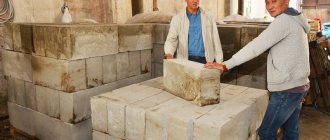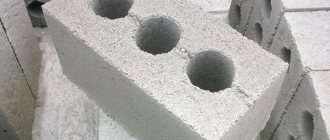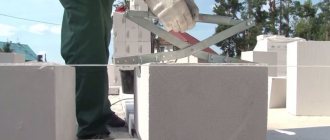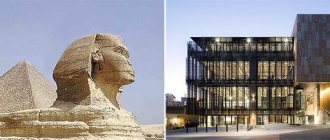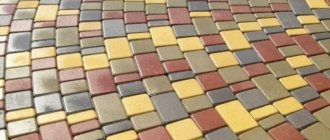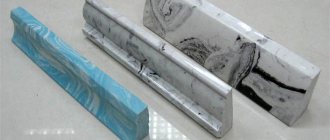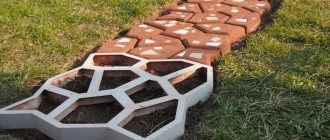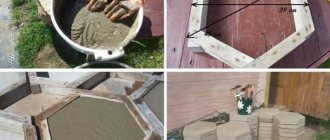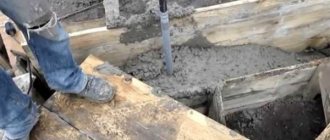In modern individual low-rise construction (buildings, retail space, warehouses, etc.) foam concrete is widely used. This is due to the low price and high performance characteristics of the material (low thermal conductivity, low weight, etc.). In many technical parameters it is better than brick and conventional concrete (reinforced concrete). In addition, foam concrete acts as insulation.
Thanks to the use of new technologies, manufacturers have managed to make this material accessible, because previously it was expensive. Therefore, today houses made of foam concrete can be found in any region of the Russian Federation.
Foam concrete characteristics
The main parameters of foam concrete are given below.
| Parameter | Meaning |
| Thermal conductivity coefficient, W/(m*C) | 0,09-0,38 |
| Density (volume weight), kg/m3 | 400-1200 |
| Brand by density | D400-800, D1000-1200 |
| Concrete compressive strength class | class B 2.5 at D700 |
| Vapor permeability, mg/mhPA | 0,2 |
| Water absorption,% by weight | 10-16 |
| Frost resistance no less | 25 cycles |
| Masonry…/masonry joint thickness, mm | for glue, solution/10mm |
| Average shrinkage of finished masonry, mm/m | 2-3 |
| Possibility of masonry reinforcement | No |
| Average thickness of a single-layer wall, m | 0,63 |
The use of foam blocks allows you to:
- Reduce the cost of construction (no need to buy additional insulation) and maintenance of the facility (foam blocks are not demanding to operate);
- Increase the thermophysical characteristics of the structure;
- Reduce the load on the building's load-bearing structures;
- Quickly build various objects (houses made of foam concrete, garages, sheds, retail space, etc.).
How to calculate the required amount of foam block for a house?
There are several ways to calculate the required amount of foam block. The most common are: independent calculation and the use of special calculators. You can easily find a foam concrete calculator on the Internet.
We will look at how you can carry out calculations without using the latter using the example of a building 3 meters high and 11*15 meters in size.
It looks like this:
- We calculate the perimeter: 11*2+15*2=52 meters; We calculate the area of all walls excluding partitions: 52*3=156 m2; We will use a block of size 625*250*300 and we will lay it at 300; We will calculate the area of the block : 0.625*0.3=0.1875 m2; We get the number of blocks in pieces: 156/0.1875=832; Convert to cubes: block volume=0.625*0.3*0.25=0.0375 m3; 1/0.0375=26.6 pieces of blocks in one cube; 832/26.6=31.28 m3 will be needed.
Since experts advise purchasing (manufacturing) products with a small supply, we will need about 33-35 m3 of blocks.
Foam concrete and aerated concrete - do not confuse
On the domestic building materials market today you can purchase two artificial, porous building materials - aerated concrete and foam concrete (according to GOST 25485-89 Cellular concrete. Technical conditions. ). They are similar in composition because they are made using cement, sand, water and a blowing agent. Thanks to the last component, the material obtains a porous structure.
But many do not understand the difference between these materials, because they have many similar parameters. The difference mainly lies in the manufacturing technology of these building materials.
When making aerated concrete, aluminum powder is added to a dry mixture of cement and sand, after which the mixture is mixed well. Next, water is added to it. After which the aluminum powder reacts with the cement, resulting in the release of hydrogen and AL oxides. Hydrogen fills the concrete mixture with bubbles, the structure of which becomes cellular (bubbles can be large - 3 mm or more or small - 1 mm or less).
With low quality material, it has a non-uniform structure in height, which is reflected in many of its parameters. High-quality aerated concrete has a uniform structure and improved characteristics.
Secrets of business success
In the previous issue, we talked about Emerson's 12 Principles of Productivity, which we promote throughout our company.
These principles were described by Emerson over 100 years ago. Emerson's main idea: true labor productivity always produces maximum results with minimal effort! These principles can be considered fundamental, and apart from business, they are suitable for any event and business. In order to be closer to the production of goods and services, we have chosen for ourselves the strategy (and tactics) of the world's leading manufacturing company today - Toyota, today it is no secret to anyone that in terms of price-quality ratio, Toyota cars are the best in the world! Here we publish some excerpts and operating principles of the Toyota enterprise, more details on our website and other Internet sources:
Foam block production technology
Fill the concrete mixer with sand, Portland cement and water in the required proportions. The apparatus is started, after which it is expected that a homogeneous mixture will be obtained. Next, the foam is prepared in a foam generator, after which it is added to the mixture, and then the required amount of hardener is poured into the solution. Next, the solution is stirred again for 3–4 minutes. With longer mixing, the foam will collapse, and the strength and other characteristics of foam concrete will decrease.
After preparing the solution, it is filled into molds prepared in advance (wooden ones are moistened with water, and iron ones with machine oil or waste). After filling out the forms, the poured blocks are left to harden for a day (sometimes you have to wait longer). Concrete must gain strength at an air temperature of 6C or more. If work is carried out in a cold workshop in winter, then it must be warmed up using a heater or a heat gun. After a day, the finished foam blocks are removed from the molds and placed on pallets.
It should be borne in mind that the better the hardener used, the faster the foam blocks harden.
In general, the entire procedure for making foam blocks takes no more than 2 days. To competently organize the technological process and increase its productivity, the following is required:
- Use water heated to 30C to mix the solution.
- To accelerate the hardening of foam concrete, calcium chloride must be added to it (≈1.5% of the total mass of the mixture). In addition, this will reduce the likelihood of block cracking. The additive must be used when performing work in winter.
- If you regularly fill foam blocks, it is better to make steaming chambers for drying foam blocks at 60C. This will reduce the production time of products.
- Use forms with cells whose dimensions comply with GOST standards.
- Wood molds must be covered with polyethylene after filling, and iron molds must be lubricated with machine oil (working off) before use.
Barotechnological method for producing foam concrete
Barotechnology involves supplying a foaming agent and water to the mixer, after which cement and quartz sand are added in the required ratio. The mixing process occurs under pressure, the resulting cavitation (the formation and collapse of air bubbles) in this case occurs in an orderly manner, which helps to achieve better homogeneity of the solution. The air cells are not only evenly distributed throughout the entire volume of the mixture, but also have approximately the same size.
This significantly improves the strength properties of the finished mortar or the resulting molded products. To carry out production using this method, it is necessary to purchase a set of equipment for the operation of the site. This is justified if there are permanent markets for finished products or large individual orders.
Equipment for the production of foam blocks at home
To produce foam concrete, the following equipment is required:
- Concrete mixer. It is permitted to use an installation for the production of cellular concrete for these purposes;
- Compressor. Necessary for pumping air into the steam generator and mixer;
- Foam generator. Allows you to prepare foam;
- Form. It is often made independently from wood or iron.
If you plan to make foam blocks year-round, you will need to additionally buy a steamer in addition to the equipment listed above. You can also assemble the installation yourself, but this will not save much money. Moreover, some elements may not fit together well, which will affect the quality of the foam blocks.
It is better to buy equipment as a set, which costs between 100,000 and 250,000 rubles. This installation will make it possible to produce 10-25 m3 of foam concrete per work shift.
When selecting equipment, you need to pay special attention to the power and characteristics of the electric drive. In addition, you need to consider the distance to which the finished solution can be supplied.
If you are building your own house and you need the equipment one-time, then it is better to rent it.
While using the equipment, it must be washed periodically.
Dry mixing method
Components and equipment for the production of foam concrete.
This technology is based on mineralization processes. Its essence is as follows.
A dry cement-sand mixture with a fraction acceptable according to the requirements is fed into a mixing device, into which ready-made foam with a low expansion structure is constantly supplied. As a result, many dispersion media arise in the air pores (shells). This method of producing foam concrete makes it possible to obtain a more homogeneous environment; productivity in this case is also higher and is justified by the continuous supply of dry components and foam from the generator.
Unlike the classic mixing of foam in a concrete mixer, production by mineralization requires special equipment and a continuous supply of components. This involves obtaining large volumes of foam concrete for large orders. The advantage of producing foam concrete products using the dry mixing method is the absence of excess volumes of water in the solution and, accordingly, increased strength characteristics of the product.
Preparation of foam concrete mixture
Making foam concrete with your own hands at home is quite simple, you just need to have the above equipment and the materials specified below.
Foam concrete is made from:
- Cement;
- Water;
- Sand;
- Foaming agent;
- Additives Improves the properties of the material. To increase frost resistance, the BIO-NM modifier is added to it. To increase air entrainment, aerating additives BIO-Lux, Siplast or PVD-3 are added.
To produce 1 m3 of high-quality foam concrete (density 600 kg/m3), you need to use the following quantities of materials:
- sand – 200 kg;
- cement – 320 kg;
- hardener - in accordance with the manufacturer's instructions;
- foaming agent – 1.2–1.5 l;
- water - 100–110 l.
The lower table shows the composition of foam concrete of some brands.
| Composition of foam concrete mixture per cubic meter | |||||
| Foam concrete brand | Amount of cement M500 (kg) | Quantity of sand (kg) | Amount of water (l) | Foaming agent quantity (kg) | |
| Foam formation | Obtaining a solution | ||||
| D600 | 310 | 210 | 55 | 110 | 1,5-2,0 |
| D800 | 320 | 420 | 45 | 120 | 1,2-1,5 |
| D1000 | 350 | 590 | 40 | 140 | 0,8-1,2 |
Manufacturing instructions
To make foam concrete yourself at home, you should study the features of the technological process, common mistakes and ways to eliminate them. In addition, you will need to find the optimal recipe for making blocks for a specific project. After preparation, you can begin the step-by-step production of products, strictly following the instructions.
Solution preparation technology
A special feature of the foam concrete production technology is the preparation of the cement mixture before work. The creation method is similar to the method of making a classic concrete solution. As a basis, you need to take the M400 or 500 brand.
The sand must be free of foreign impurities or additives. The solvent for the components is simple water, which can be taken from the central water supply. Foam is added to the finished mixture, which is created using a foam generator. After adding foam, the kneading process should not exceed 2.5 minutes - otherwise the structure will be damaged.
Pouring and drying
The next stage of foam concrete production is pouring the mixture into prepared molds. Before use, the containers are lubricated with a special solution , which facilitates the process of removing the finished product. This technique is called “casting”, but there is also cutting technology.
Procedure:
- Pour the prepared mixture by lightly tapping on the sides or bayoneting. This will allow the mixture to be evenly distributed, eliminating the formation of voids that negatively affect the characteristics of the product. The number of cells is selected in an individual format. For home production, it is recommended to make 40 pieces in one block. This is the optimal quantity for uninterrupted operation, when the next batch is being prepared during the installation of the first batch.
- After 24 hours, the solution hardens so much that the molds can be broken. Then they are filled with a new foam concrete mixture.
- Finished blocks are left to dry on pallets before they are put into construction or sent for storage. Drying time can be up to 48 hours.
Valera
The voice of the construction guru
Ask a Question
The injection molding method has disadvantages, for example, there is a risk of deforming the product during removal. Installation of a structure with curved geometry is difficult, and low-quality blocks reduce the strength of the building. However, cutting technology is considered expensive, and professional equipment is required to operate. Using the casting method is economically feasible and if you act carefully, you can get high-quality foam concrete blocks.
Foam concrete is produced using the following technologies:
Two-stage (using a foaming agent)
In addition to the low-speed mixer, this line includes a foam generator, which allows you to properly prepare the foam agent. After filling the mixer with foam, the remaining concrete components are poured into it, after which it is all thoroughly mixed at a mixer rotation speed of 25 rpm.
After preparing the solution, it is fed through pipelines into molds.
It is necessary to note the advantages of this technology:
Pores are formed through a controlled process, which allows products to be made with the required density and thermal conductivity. The material turns out fine-meshed. Due to forced foaming, the quality of foam concrete increases.
The disadvantages include:
Higher price of equipment. The high cost of the foam block because a foaming agent is required. There are fewer possibilities in the process of supplying the mixture through pipelines, especially vertically.
Dry mineralization method
In this case, air cells in the solution are formed due to physical processes, and not with the help of a foaming agent. But such work is very responsible, since you have to use high-pressure containers.
The main element of the installation for the production of foam concrete is a pressure unit, which is made in the form of a mixer for dry mixing of materials, but it operates at high speeds (420 rpm). Thanks to the high rotation speed, the solution is mixed and mixed under high pressure. As a result, air bubbles do not “open”, but their shape, size and quantity are retained. Therefore, the finished material has an even porous structure.
In addition, dry mineralization allows the solution to be supplied through a pipeline to a height of 10 -30 m. This technology is low-cost because the equipment is not expensive.
Most often this method is used in continuous production. It makes it possible to produce very durable foam concrete, but it has worse thermal conductivity characteristics.
A brief overview of the 14 principles that make up the Toyota Way
- Make management decisions with a long-term perspective, even if it is detrimental to short-term financial goals. Continuous flow process helps identify problems. Use a pull system to avoid overproduction. Distribute work evenly (heijunsh): work like the tortoise, not the hare. .Make stopping production to solve problems part of the production culture when quality demands it. Standard tasks are the basis for continuous improvement and delegation of authority to employees. Use visual inspection so that no problem goes unnoticed. Use only reliable, proven technology. Develop leaders, who thoroughly know their business, profess the company's philosophy and can teach this to others. Raise extraordinary people and form teams that profess the company's philosophy. Respect your partners and suppliers, set difficult tasks for them and help them improve. To understand the situation, you need to see everything with your own eyes (genchi genbutsu). Make a decision slowly, based on consensus, after weighing all possible options; implement it without delay (nemawashi). Become a learning structure through relentless self-reflection (hansei) and continuous improvement (kaizen).
Read more about the principles of the approach in the book 14 principles that make up the Toyota approach.
We share small business experience and technologies
Summer time is a great opportunity to take a break from the daily routine, as well as spend time doing an interesting and useful activity - reading books. What works should you definitely pay attention to this summer?
This article examines two options for obtaining design documentation: either you order the development of a house project from an architect, or you buy a house project. Both methods have their advantages over each other...
Before you determine for yourself the advantages or disadvantages of a heated floor.
It is necessary to understand what types of heating systems exist, the conditions, installation possibilities in premises with certain architectural solutions (house, apartment, office, industrial premises), as well as further operation. Here, only desire and material capabilities are not enough. Underfloor heating systems are divided ...
Foam concrete is a material that consists of a hardened cement-sand mixture containing closed cellular formations filled with air inside. The physical characteristics and scope of its application depend on the grade of cement used, the volume fraction of sand and the foam content obtained from the foaming agent.
Foam concrete production diagram.
The preparation of foam concrete can take place at large concrete plants and small specialized plants.
The main condition for obtaining a quality product that meets standards is compliance with production technology. You can produce similar concrete in small quantities yourself. This requires certain equipment and knowledge of the recipe for obtaining the required mixture.
Production of foam concrete using a foam generator
Producing foam concrete using a foam generator is not a complicated process. First, mix the mixture in advance, then soak it in water (observing the proportions). Then the liquid solution is fed under pressure into a foam generator, where it foams. As for the proportion of foam concentrate in relation to concrete, it varies between 0.5-1.5 kg per 1 m3. You should always do one filling per 4-6 m3 of concrete.
Technology for preparing the necessary components
Diagram of the foam generator device.
The production of foam concrete involves the use of Portland cement grades 400 and 500. The use of grade 500 cement will provide improved strength characteristics at the same density as a mortar containing M400 cement. Hardening time will also be reduced. The sand selected is quartz, fine fraction. It is desirable that the size of sand grains ranges from 1-2.5 mm. The addition of river sand to the solution is justified by its homogeneity and the absence of various pollutants. The content of clay inclusions should be minimal and tested in a laboratory. The preparation of cellular concrete must take into account the exact value of the water-cement ratio, characterized by the mass content of dry components and added water. Thus, as a result of introducing a volume of foam into a solution with a water-cement ratio below 0.38, it can lead to the removal of water with a sharp deterioration in the formation of air cells. An increased index (above 0.58) is capable of the formation of free water, which worsens the strength properties of the material.
Molding foam blocks
Today injection molding and cutting molding are used.
The first method involves pouring foam concrete into cellular forms, which you buy or make yourself. Thanks to this, this method is considered the most accessible. In construction, foam blocks of different sizes are sometimes required, so you need to prepare forms with cells of the required sizes in advance. When cast blocks are removed from their molds, the edges are often damaged.
In the second case, a large formwork is filled with a liquid solution, which is removed after the solution has hardened. Next, a large piece of foam concrete is cut into small blocks using a special installation, which contains cutting strings, tapes or saws. This allows us to produce more even blocks of the required size, and they never chip.
The disadvantage of this method is cutting, since this is a rather complex and labor-intensive process that requires some experience.
Economic feasibility
Since we have figured out how to make foam concrete, it is worth saying a few words about the economic feasibility of this process.
Possible savings depend on several factors:
- Availability of skills in production; Equipment used and its cost; Number of defective products; Cost of raw materials and many others.
In general, if we assume that the average cost of 1 m3 of a block is approximately 3500 rubles, and the cost of self-produced products is 2800 rubles, then when producing 80 m3, the savings will be: 3500-2800 = 700 rubles; 700*80=56000 rubles.
If we consider that the equipment will cost 40,000 rubles, then the net savings will be 26,000.
Foam blocks: sizes, pros and cons for building a house
The table below shows the block sizes.
| Block sizes, mm | Weight depending on the type of foam concrete, kg | |||||||||
| D300 | D400 | D500 | D600 | D700 | D800 | D900 | D1000 | D1100 | D1200 | |
| Wall foam blocks | ||||||||||
| 200x300x600 | 11,7 | 15,6 | 19.4 | 23.3 | 27.2 | 31.7 | 35.6 | 39.6 | 43.6 | 47.5 |
| Partition blocks | ||||||||||
| 100x300x600 | 5,8 | 7,8 | 9,7 | 11,7 | 13,6 | 15,8 | 17,8 | 19,8 | 21,8 | 23,8 |
The table shows that each brand of block differs in weight.
They also produce large-format products, but to work with them you need lifting equipment. But thanks to them, it is possible to speed up any construction. Large-format foam concrete blocks have the following dimensions:
- 1000x600x600 mm;
- 1000x600x500 mm;
- 1000x600x400 mm;
- 1000x600x300 mm.
They also make small-format blocks, used mainly for insulation, and less often for the construction of thin walls in places where it is necessary. Such foam concrete blocks have the following dimensions:
- 600x300x100 mm;
- 600x300x150 mm.
Advantages and disadvantages
Foam block has the following advantages:
- Inexpensive (brick costs more);
- Has high thermal insulation parameters.
- Thermal conductivity of foam concrete is 0.08-0.20 W/mS. This characteristic makes it possible to reduce the heat loss of the building by 30% compared to a brick building;
- Easy to process and install;
- It weighs little, so the load on supporting structures is less; Allows you to make a variety of attractive architectural elements: arches, columns or portals;
- It is a non-flammable material;
- Long lasting. The service life of a structure built from foam blocks is at least 35 years;
- Ecologically pure. Foam blocks are made from natural materials, so they do not rot, and fungus or mold does not appear on them;
- It has high sound-absorbing characteristics, which will protect the living space from any external sources of noise.
Disadvantages of the material:
- Low strength;
- Absorbs moisture;
- Large shrinkage.
How to make blocks yourself?
Typically, foam concrete is produced according to a fairly simple scheme:
Foam block production diagram
- a cement-sand mortar with certain characteristics is prepared;
- form a mixture from a foaming agent;
- prepare a mixture of foam concrete;
- Blocks are formed from the finished solution.
The proportions of materials used always depend on the density of foam concrete that needs to be obtained at the output. It can vary from 200 to 1500 kg/cubic meter. m.
To obtain a material with medium density, it is recommended to prepare a solution where the ratio of the main ingredients will be:
- sand – 1 part;
- cement – 1-1.5 parts;
- foaming agent – 4 g per 1 kg of cement;
- water - as needed.
Cement mortar manufacturing technology
To prepare cement mortar for foam concrete, adhere to the following rules:
Approximate mixture proportions for foam concrete
- pure cement with grade strength M400, M500 is used. 85% of the material should pass through a 008 mesh sieve;
- use sand without clay inclusions, which is resistant to aggressive external influences;
- Tap water can be used, but it should not contain acid or salt impurities.
After preparing the necessary ingredients, they begin to mix them using a special generator. It is necessary to obtain a solution with a uniform structure.
Preparing the foaming agent
To make foam blocks with your own hands, you can use foaming agents that are sold ready-made or try to create this mixture yourself. To do this, you need to prepare the following materials:
- caustic soda – 150 g;
- wood glue – 60 g;
- rosin – 1 kg.
These ingredients are first crushed and then mixed until a mixture with a homogeneous consistency is obtained. The resulting solution is added to previously prepared concrete.
It must be remembered that a concentrated foaming agent is obtained using this method. It must be mixed with water. Depending on the required density of foam concrete, the foam concentrate consumption will be 0.25-1.2 liters per 1 cubic meter. m of concrete.
What properties does high-quality foam concrete have?
Foam concrete is a popular building material with the following advantages:
- increased thermal insulation properties due to the cellular structure. Heating foam block buildings requires less expenditure, since they retain heat better;
- resistance to negative temperatures with subsequent thawing. The integrity of foam blocks is maintained throughout 40-50 deep freezing cycles;
The material is not afraid of chemical influences and resists precipitation well
- resistance to the effects of elevated temperatures caused by contact with open fire. In fire hazardous situations, the integrity of foam concrete structures is maintained;
- high noise insulation characteristics, which ensure comfortable indoor conditions. Material with a porous structure effectively absorbs external noise;
- breathability, helping to maintain comfortable humidity and air exchange. Microorganisms do not develop in a foam concrete room and colonies of fungi do not form.
No less important advantages of foam concrete also include:
- environmental cleanliness;
- low cost of self-production;
- ease of machining;
- increased dimensions of foam blocks;
- light weight of products.
Along with its advantages, even high-quality foam concrete has some disadvantages:
- increased hygroscopicity. Foam concrete walls need reliable protection;
- increased fragility. During transportation and laying, blocks should be protected from mechanical damage.
Despite the disadvantages, developers prefer foam concrete due to the serious advantages of the material.
What is the difference between a factory unit and a product made independently?
- The factory block has better geometry. This means that the thickness of the layer during laying will be smaller, and, consequently, the number of cold bridges will also be reduced. In most cases, products made by hand are less durable. They are not controlled by anyone and may well not meet technical requirements. The latter may have reduced durability and other performance characteristics. The color of a non-autoclaved self-produced block is gray, while autoclaved factory products are lighter. A non-autoclaved foam block is also more fragile and shrinks more susceptible.
These and other reasons often push developers to abandon experiments with self-production.
Note: The only significant advantage of producing foam blocks yourself is, of course, the price, since the opportunity to save money attracts many. However, we note that in the end the savings will not be very noticeable - at least if you try to produce the highest quality products.
Design features of the equipment
- Feed module. It is filled with the mixture from which the foam is to be formed. The element can be replaced with any other container.
- Conversion module. Purpose – creation of finished foam;
- Dosage module. Thanks to it, the material is supplied in parts and dosed. If the construction is not capital, then it is quite possible to do without this element.
From the above, it becomes clear that only the converter needs to be manufactured; to do this, use the following diagram:
Main element design
Assembly occurs according to the following scheme
Assembly sequence
First of all, the mixing container is placed on the floor and a hose is connected to it to supply the emulsion. With the help of a pump, you can ensure efficient and smooth operation of the foam concentrate. But if your budget is limited, then you can do without it.
Formation of foam concrete in formwork or in bulk
The second process in the production of foam concrete is its formation into a block using formwork or cutting the mass. Regardless of the technology used to prepare the foam concrete mixture, if it is poured into low-quality formwork, its value is worthless.
Formwork is a sore point in the production of foam concrete. What is it not made from? Made from plywood, slate, polycarbonate and God knows what else. To save money, metal formworks use cheap grades of steel that are not resistant to cement. There are formworks without a bottom, located on a concrete base.
In the formwork, the block can be positioned both horizontally and vertically. The latter leads to uneven drying and early setting of the top of the block. The bottom takes longer to dry, which leads to internal tension in the block and its cracking.
Video: Monolithic foam concrete in permanent formwork
All of the above affects the geometry and quality of the formed blocks. And here foam concrete loses to aerated concrete blocks.
The negative factor is added by lubricating the formwork for better “release” of the blocks. Using a special solution is expensive and not always available. Therefore, they lubricate the formwork with anything - emulsol, mining, vegetable oils and even lard. All this reduces the adhesion of the material significantly. In this aspect, foam concrete is also inferior to aerated concrete blocks.
Taking these points into account, equipment manufacturers have developed industrial automated complexes where foam concrete is cast in bulk and only then cut. This made it possible to produce blocks with excellent geometry and adhesion, which makes foam concrete a leader among cellular concrete. Subsequent “maturation” of foam concrete.
This is also an important stage of the production process. No equipment manufacturer will tell you about it. After the blocks are formed, the foam concrete must “mature” for 28 days in “comfortable” conditions for it. It should be tightly covered with polyethylene and not exposed to drafts.
Now let’s imagine for a moment the average production of 20 cubic meters per day. One Euro pallet contains 1.18 cubic meters of foam concrete blocks. Taking into account the maneuvers of the loader, about 20 square meters are needed every day. meters of warehouse space. Multiply by 28 and we get that only for storing finished products you need 560 sq. meters, excluding areas for production and storage of components.
In the photo: Foam concrete blocks.
From a financial perspective, to organize production, working capital is needed that can cover all production costs without revenue for at least one month.
In fact, the future of foam concrete lies in automated complexes with cutting technology. Casting foam concrete into formwork should become a thing of the past.
Methods for obtaining finished products
Various methods for producing blocks allow you to obtain finished products as follows:
- The method of pouring liquid foam concrete into group metal formworks, in which the hardening process is carried out for 10 hours, followed by disassembling the form. The technology makes it possible to use one form twice within one day. This method, with small financial investments and ease of manufacture, does not allow the production of significant volumes of products, and is tied to the size of the molds.
- By cutting the foam concrete mass using special cutting equipment.
The pre-prepared composition is supplied into solid forms, where there are no partitions. It freezes into a single mass. 12 hours after pouring, the composite is cut using automatic saws. The method makes it possible to obtain finished blocks of the required size, is highly efficient, but at the same time is quite expensive and is accompanied by the presence of waste obtained during sawing. The finished foam concrete is placed in one large formwork, where it gains its initial strength, after which this monolith is freed from this form and cut into blocks using a special machine - A method of group casting of foam material into special molds and their automatic disassembly after hardening of the composition in a special installation with the delivery of the finished product to a pallet. The equipment automatically extrudes blocks. The difference between this method is its high productivity and simplicity, but it allows the production of products of a certain standard size, according to the dimensions of a special shape, since the equipment requires reconfiguration.
Comparison of foam block with the main competing materials
Let’s use the table and compare the properties of foam concrete with other equally popular building materials.
Comparison of foam block with products made from other materials:
Name of property Foam concrete Expanded clay concrete Polystyrene concrete Aerated concrete Ceramic brick Density, D300-1200400-2000150-600300-12001400-2100 Frost resistance grade 25-10025-20025-15025-15025-300 Thermal conductivity, W*mS 0.07-0.40.14-0.50.05-0.170.08-0.380 .56-0.7 Shrinkage Up to 1 mm/m2 Not affected Up to 1 mm/m20.3-0.5 mm/m2 Up to 10% Water absorption, % 15% 18% 5% 25% 5-10%
